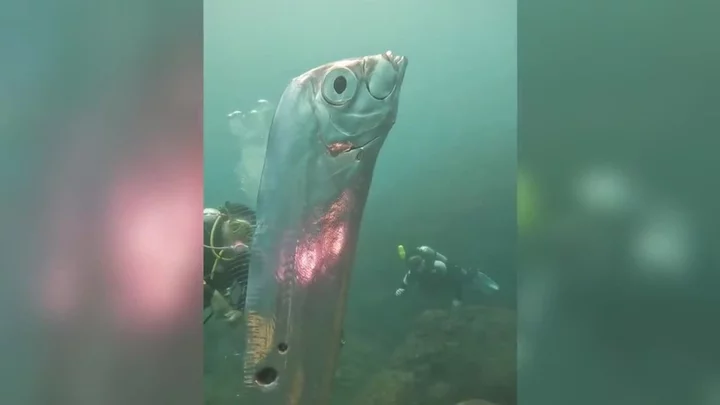A rare six-foot “earthquake fish” dubbed a “harbinger of doom” has been spotted, sparking doomsday theories.
A group of divers have come across an enormous deep-sea creature with chunks bitten out of its body.
The Russell's oarfish, regarded by some as a sign of forthcoming bad news, had several round bite marks believed to have been caused by a cookiecutter shark.
It was spotted near the ocean surface and divers believe the large fish was about to die.
Sign up to our free Indy100 weekly newsletter
Diving instructor Wang Cheng-Ru said: “It must have been dying so it swam into shallower waters.”
However, some locals believe oarfish swim to the surface just before an earthquake hits.
Wang took images of the oarfish off the coast of Ruifang, in Taiwan. He said it was the first time he had ever encountered one in all his years of scuba diving.
The injured Russell's oarfish appeared to be about two metres in length. Due to their size and shape, oarfish resemble ‘sea serpents’ and are considered harbingers of earthquakes and misfortune in Japanese mythology. The myth was rekindled in 2011 after the Tōhoku earthquake and tsunami.
Shortly before the disaster, at least a dozen of the rarely seen fish washed ashore in Japan in late 2009 and 2010. Despite their links to natural disasters, the Ecuadoran Geophysical Institute said the myth has no validity in any scientific study carried out as of August 2022.
Oarfish are considered one of the longest fish in the ocean and can measure up to 17 metres (56 ft) in length and weigh over 200 kgs (441 lbs).
Their body is scaleless and the skin has a slimy, silvery protective coating known as guanine. Their dorsal fin starts between its eyes and reaches its tail. Due to its ability to adapt to different temperatures, oarfish are found in most of the world's oceans with the exception of the poles.
They live at depths of up to 1,000 metres (3,280 feet) and sightings are not very common. Sometimes they wash up on beaches after a storm or when they suffer a serious injury.
Have your say in our news democracy. Click the upvote icon at the top of the page to help raise this article through the indy100 rankings.

